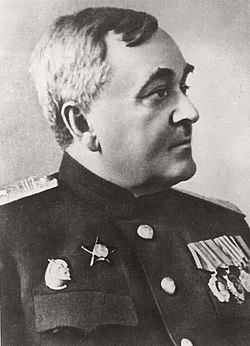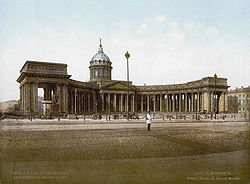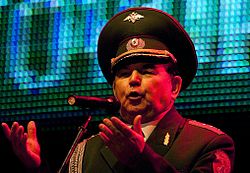Alexandrov Ensemble


The Alexandrov Ensemble (Russian: Ансамбль Александрова, romanized: Ansambl' Aleksandrova), commonly known as the Red Army Choir in the West, is an official army choir of the Russian armed forces. Founded during the Soviet era, the ensemble consists of a male choir, an orchestra, and a dance ensemble.
The Ensemble has entertained audiences both in Russia and throughout the world, performing a range of music including folk tunes, hymns, operatic arias and popular music. The group's repertoire has included The Volga Boatmen's Song, Katyusha, Kalinka, and Ave Maria.
It is named for its first director, Alexander Vasilyevich Alexandrov (1883–1946). Its formal name since 1998 has been A. V. Alexandrov Academic Song and Dance Ensemble of the Russian Army (Russian: Академи́ческий анса́мбль пе́сни и пля́ски Росси́йской А́рмии и́мени А. В. Алекса́ндрова, romanized: Akademíchesky ansámbl′ pésni i plyáski Rossýskoy Ármii ímeni A. V. Aleksándrova), shortened to Academic Ensemble (Russian: Академи́ческий анса́мбль, romanized: Akademíchesky ansámbl′) on second reference.
On 25 December 2016, its artistic director, Valery Khalilov, and 63 other members of the Ensemble were killed in the Russian Defence Ministry aircraft crash of a 1983 Tupolev Tu-154 into the Black Sea just after takeoff from the southern resort city of Sochi, Russia. The Red Army Choir singers and dancers were en route to Syria to entertain Russian troops there for Orthodox Christmas celebrations.
Name
At the establishment, in 1928, the choir was named Red Army Song Ensemble of the M. V. Frunze Red Army Central House (Russian: Анса́мбль красноарме́йской пе́сни Центра́льного до́ма Кра́сной А́рмии и́мени М. В. Фру́нзе, romanized: Ansámbl′ krasnoarméyskoy pésni Tsentrál′nogo dóma Krásnoy Ármii ímeni M. V. Frúnze). In 1935, it was renamed Red-Bannered Red Army Song and Dance Ensemble of the USSR (Russian: Краснознамённый анса́мбль ��расноарме́йской пе́сни и пля́ски СССР, romanized: Krasnozamyónny ansámbl′ krasnoarméyskoy pésni i plyáski SSSR).
In 1949 the ensemble was officially named the A. V. Alexandrov Twice Red-bannered and Red-starred Song and Dance Ensemble of the Soviet Army (Дважды Краснознамённый ордена Красной Звезды ансамбль песни и пляски Советской Армии имени А. В. Александрова Russian: Два́жды Краснознамённый о́рдена Кра́сной Звезды́ анса́мбль пе́сни и пля́ски Сове́тской А́рмии и́мени А. В. Алекса́ндрова, romanized: Dvázhdy Krasnoznamyonny órdena Krásnoy Zvezdý ansámbl′ pésni i plyáski Sovétskoy Ármii ímeni A. V. Aleksándrova). In 1978 the word "academic" was added to the title (A. V. Alexandrov Twice Red-bannered and Red-starred Academic Song and Dance Ensemble of the Soviet Army). After the dissolution of the Soviet Union, the ensemble received its present name in 1998.
History
Early years

Born into a peasant family, Alexander Vasilyevich Alexandrov became the first artistic director of the ensemble, choirmaster, conductor, teacher and the public figure who wrote the music to the State Anthem of the Soviet Union. He came from a musical background of hymns and folk songs, could play the viola and had perfect pitch, so he sang in the church choir and performed at festivals. He was heard singing at the village school by PA Zalivuhin, a soloist in the choir at Kazan Cathedral, St. Petersburg. Zalivuhin persuaded Alexandrov's parents to let the child go to Saint Petersburg to learn music. In 1898, the young peasant boy became a pupil of the Saint Petersburg Court Chapel.

There are two recorded histories of the ensemble: possibly separate elements of the same history. The first says that the initiator of the ensemble was Felix Nikolaevich Danilovich, a theatre director. The first director of the ensemble was chosen from three of Moscow's conductors: Danilin, Chesnokov and Alexandrov. Seen in isolation this would signify that A. V. Alexandrov was not the creator of the ensemble. In this version the first troupe is named as follows. Singers: Tkachenko, Zyukov, Samarin, Rozanov, Koltypin, Tolskov, Golyaev, Charov. Dancers: Maximov, Svetlov. Bayanist: Surdin.[specify]
The second version says that the ensemble was formed out of the Frunze Red Army Central House in 1928. There is also a story that Stalin then asked Alexandrov to relocate the choir to Moscow.
Development
During World War II, the ensemble gave over 1500 performances at both Soviet fronts, entertaining troops about to go into battle, at gun emplacements, airfields, and in hospitals.[needs update][needs update]
Under Boris Alexandrovich Alexandrov
Following the death of Alexander Alexandrov, the ensemble was taken over by his son, Boris Alexandrovich Alexandrov. Under his leadership, the ensemble gained fame outside the Soviet Union, making extensive tours worldwide. Boris Alexandrov retired in 1987, and was succeeded by People's Artist of Russia Igor Agafonnikov the same year, with Anatoly Maltsev as the ensemble chief. He retired as the principal conductor in 1994; he died that year and was buried in Moscow at the Novodevichy Cemetery.
Under B. A. Alexandrov, the ensemble was highly disciplined. Boris's party trick was to leave the stage and allow the ensemble to perform "En Route" alone. Members were positioned so that they could not all watch one orchestral leader, and this appeared to be a trick, but there was no trick at all. Leonid Kharitonov remembers:

Major Vladimir Alexandrov (1910–1978), brother of Boris Alexandrov, also composed for the ensemble. He served as Orchestral Director and Conductor. Vladimir Gordeev was the principal conductor on the 1988 UK tour.
1948 Berlin Peace Concert

In 1948 much of Berlin was still ruined after World War II, and the city was divided into four occupation zones, controlled by the USSR, France, the UK and the United States. This was before the Berlin Wall was built, and it was still possible to travel between zones. An American officer suggested a concert in the Gendarmenmarkt (in the Soviet zone at the time), and the French zone commander supported the suggestion. The musicians were to be provided by the USSR, and the Alexandrov Ensemble was chosen. A temporary stage was set up in the square, with flowers all along the front. 30,000 people came to stand and watch for three hours. In 1994, towards the end of his life, Boris Alexandrov said:
A previous tour to East Germany had been cancelled due to the sudden death of Alexander Alexandrov in 1946 in Potsdam, when in his bed was found an annotated copy of Beethoven's Symphony No. 9, showing that A. Alexandrov had been preparing the final chorus for a performance. Now Boris, his son, was ready to follow his father's plan. The 1948 peace concert was to consist of German opera extracts and Russian folk songs (Nightingales, Zemlyanka and Roads); and after an intervention by the tenor Victor Nikitin, some German folk songs were also included. The people joined in, singing Heidenröslein, and Nikitin sang Kalinka three times in a row. The concert was very successful, and very moving. A sound recording of the concert was made, and pressed in 1985 under the Radio DDR 1 label. This is listed on the Alexandrov Ensemble discography page.
However the Berlin Peace Concert did not happen in isolation. It was part of a series of punishing yearly tours to war-torn areas. The main tour season during and just after World War II appears to have run from June to October – perhaps because the large troupe usually had to perform outdoors, to accommodate large audiences. The August 1948 Berlin concert occurred two-thirds of the way through a tour to (20 June to 18 July) Prague, Most, Brno, Bratislava, Ostrava, Žilina and Košice in Czechoslovakia; then apparently without a break (18 July to 10 October) Dresden, Weimar, Magdeburg, Stendal, Schwerin, Potsdam, Berlin, Rathenow, Leipzig, Halle, Lane, Erfurt, Chemnitz, Frankfurt an der Oder and Schwarzenberg in Germany.
After 1991
Today, the ensemble is led by Honoured Artist of Russia Vyacheslav Korobko, who has been leading it since 2003.
Until 1969, the standard uniform for the ensemble choir, soloists and orchestra was the tunic and riding breeches. On 1 January 1970, this was changed to dress uniform,[specify] and there have been further variations to the dress uniform as used by the ensemble since 1970.
Eurovision Song Contest 2009
The choir were the interval act in the first semi-final of Eurovision Song Contest 2009 in Moscow, alongside t.A.T.u who performed "Not Gonna Get Us".
2016 plane crash
On 25 December 2016, a Russian Defence Ministry Tupolev Tu-154 carrying 64 members of the Alexandrov Ensemble Choir went down 1.5 km (0.93 mi) off the coast of Sochi, Russia while en route to Latakia, Syria for a Christmas celebration with the troops deployed at Khmeimim military base. The plane crashed with no survivors.
After 5 weeks, the choir was reformed anew in time for Defender of the Fatherland Day celebrations on 18 February 2017. That first concert in weeks marks also the birth of a new era for the Ensemble, with its first international tour following the crash with concerts not just in Russia but also in select European countries. Most of the new members joined through auditions held on 15 and 27 January 2017 by the Ministry of Defense of Russia. Since 7 June 2016, Colonel Gennadiy Sachenyuk became artistic director then main conductor and Head of the Ensemble since 24 March 2017.
2018 90th Anniversary
On 12 October 2018, the Ensemble celebrated the 90th anniversary of its foundation at a special event at the Bolshoi Theatre. Following this event, the leader of the Ensemble Colonel Gennadiy Sachenyuk announced a worldwide tour. The Ensemble performed concerts produced by Thierry Wolf in various countries including France, Switzerland, Belgium, Serbia, the Czech Republic and China. In December 2019, they celebrated Christmas in Montreal during a week of seven concerts at La Maison Symphonique.
2022 Russian invasion of Ukraine
Following the ongoing Russian invasion of Ukraine on 24 February 2022, the tour Alexandrov Ensemble was supposed to have in the Czech Republic has been canceled, while individual members of the choir have faced disqualifications from competitions such as Operalia.
Composition
Soloists

Most notable soloists:
- Evgeny Belyaev
- Victor Ivanovich Nikitin
- Leonid Kharitonov
- Mark Reizen
- Georgi Pavlovich Vinogradov
- Vadim Anayev
- Ivan Bukreev
- V. Chetverikov
Chorus
Current members of the choir are listed here. The choir consists mainly of vocal sections of tenor, baritone, and bass. In some of the pieces they perform, these sections are divided into as many as eight different vocal lines. From the early 1950s until at least 1965 a typical full division (which varied from song to song) was as follows: (1) countertenors; (2) first tenors; (3) second tenors; (4) baritones; (5) first bass; (6) second bass; (7) basso profundos.
Orchestra

The orchestra, in what became a typical composition for later generations of military ensembles in the Soviet Union, has a mixed composition of Russian traditional instruments and western instruments, including the balalaika, the domra, the bayan, the double bass, woodwinds, brass, and percussion instruments. A great guest balalaika player was Boris Stepanovich Feoktistov (Борис Степанович Феоктистов) (1910–1988). In the West his most famous recording is Kamarinskaya (1963). A. Molostov is the trumpet soloist in "Dark Eyes" in vintage recordings. The bayan-player Victor Gridin is a past member of the orchestra.
Dancers

Among the dances staged by the ensemble are Zaparozhtsi Dance, Cossack's Cavalry Dance, Festive March, Dance of the Cossacks, Soldier's Dance, and Sailor's Dance. Some of these are performed by mixed dancers, while others, such as Cossack's Cavalry Dance, are performed by male dancers only.

Current line-up
The artistic director was Valery Khalilov but he, and 63 other members of the Ensemble, were killed in an aircraft crash on 25 December 2016. The chief choreographer is People's Artist of Russia L. Kulikov; the chief administrator is Honoured Artist of Russia VG Kadin, the choreographer and coach is the Honoured Artist of Russia V. Ermolin; head dresser is Honoured Worker of Culture A. Kormilitsyn; soloists are VI Shtefutsa and EM Labkovsky; with SV Ivanov, PD Bogachev, VP Maystruk, AA Gvozdetsky, BM Mizyuk: all Honoured Artist of Russia.
In the choir are YA Lysenko, Y. Shtrunov, IM Pirogov, IS Sobolev, IF Volkov, OV Filimonov, AN Savitsky, VA Nagorny, VP Kokarev, AA Hristachev, JN Deynekin, VM Bolonenko, VN Antonov, AN Stritenko, AA Toschev: all Honoured Artist of Russia; and VS Buzlov, SP Lapik, VF Orthodox, GU Razgasimov, V. Chekin, MD Mochalina.
In the orchestra are AA Mogulkin, Y. Savkin, MG Chervov, PD Shchennikov, NI Diakov, AI Egorov, VM Predelin: all Honoured Artist of Russia. Vocal coaches are People's Artist of Russia, laureate of competitions, MI Glinka and PI Tchaikovsky, Professor KP Lisovsky. The Principal Concertmaster is Honoured Artist of Russia V. Brodsky.
In the ballet are GD Pavlyuchenko, IV Konygina, P.U. Khmelnitski: all Honoured Artist of Russia. In 2019, the Ensemble touring all over the world with famous soloist as Valery Gavva or Vadim Ananeev but also young soloists such as Alexander Kruze or Maxim Maklakov, former soloit of Kraznodar Opera or very young talent such as Sergey Kuznetsov. Under the direction of conductor Gennadiy Sachenyuk
Composers and directors
Directors of the Ensemble and orchestra, and Assistant Conductors
- 1928–1946 – Major General Alexander Vasilyevich Alexandrov, People's Artist of the Soviet Union, founding artistic director and conductor of the Ensemble, awarded the Stalin Prize, composed the State Anthem of the Soviet Union and various other songs for the ensemble
- 1946–1987 – Major General Boris Alexandrovich Alexandrov, Hero of Socialist Labor, People's Artist of the Soviet Union, awarded both the Lenin Prize and the Stalin Prize, son of the founder, composer and led the ensemble on a number of national and international engagements
- 1987–1992 – Professor Colonel Anatoly Maltsev, People's Artist of Russia, led the Ensemble through the dissolution of the Soviet Union and the armed forces, served as Assistant Conductor until 1987
- 1992–1993 – Colonel Igor Germanovich Agafonnikov (until 1992 conductor and artistic director for the orchestra, also served as deputy and relief conductor)
- 1993–2002 – Colonel Dmitry Vasilyevich Somov
- 1994–2002 – Colonel Victor A. Fedorov, Choir Master and relief conductor
- 2003–2016 – Colonel Leonid Malev, Honoured Artist and Honoured Cultural Worker, responsible for the choir's renewed international tours including a memorable concert at the Vatican in 2004
- 2008–2012 – Prof. Colonel Igor Raevskiy, People's Artist of Russia, Honoured Artist of Belarus, awarded the State Prize of Czechoslovakia
- 2012–2016, 2017–present – Colonel Gennady Ksenafontovich Sachenyuk, Honoured Cultural Worker of Russia, current artistic director, Principal Conductor and Head of the Ensemble
- 2016 (May–December) – Prof. Lieutenant General Valery Khalilov, People's Artist of Russia, highest-ranking officer to serve as Artistic Director
- Second conductor, Lieutenant Colonel Nikolay Kirillov, People's Artist of Russia, Chief Conductor and assistant director of the ensemble
- Choirmaster- Sergey Sokolov.
- Present days – 13 September 2019, Gennadiy Sachenyuk, nicknamed the Maestro, Conductor and Director of the Ensemble since 2016, was honored with the highest level medal for Russian artist.
Composers and assistant directors
- Kostiantyn Dankevych (1905–1984): a Ukrainian who was director of Songs and Dance of the Red Army Choir in Tbilisi, and wrote Poem of Ukraine.
- Lev Knipper (1898–1974) who composed Polyushko Pole, and Viktor Gusev (1909–1944) who wrote the lyrics.
- Pavlo Virsky who was artistic director of the Alexandrov Ensemble dancers from 1942, for many years.
- Samuel Pokrass (1897–1939) who wrote White Army, Black Baron or Red Army is Strongest; lyrics by P. Grigoriev.
The repertoire

In 2006 and 2007, in Moscow and in Vladikavkaz, Grozny, the ensemble performed a New Year fairy tale show for children, Ivan the Good, Ivan the Brave, about a soldier helping to save New Year's Day.
In 2008, the 80th anniversary of the ensemble, director Leonid Malev said:
The Children's Choir School
The Alexandrov children's choir school was founded in 2007. Malev said about the school:
Films
The ensemble under the direction of Boris Alexandrov can be heard singing It's a Long Way to Tipperary in the 1981 film Das Boot. Members of the ensemble are seen performing The Internationale in New York's Grand Central Station in Peter Miller's 2000 documentary The Internationale. Several films have been made of the ensemble's performances: see Alexandrov Ensemble discography.
Awards for the ensemble
- For global recognition of high art: The Global Team Award
- From the French Academy of Records, for the best record: Gold Disk (1961)
- From the French company Chant Du Monde, for record sales: Gold disk (1964)
- Order of the Mongolian Combat Merit (1964)
- Czechoslovak Order of the Red Star (1965)
- From the Dutch company N.O.K, for record sales: Gold disk (1974)
- Two awards of the Order of the Red Banner
- The honorary title of academy (1979)
See also
References
External links
- Official website

- Tribute to the lost members of the Ensemble by former soloist Leonid Kharitonov, 26 December 2016 In Russian with English subtitles
- Russia Beyond the Headlines: Interview with Leonid Malev 2008 Archived 11 July 2012 at the Wayback Machine
- Translated Sovmusic.ru webpage: Biog. of AV Alexandrov and list of early tracks recorded by Ensemble.
- Rg.ru webpage: interview with Ensemble director Leonid Maleev, by Yadviga Yuferova, 2007 In Russian.
- Images of The 1948 Berlin Peace Concert